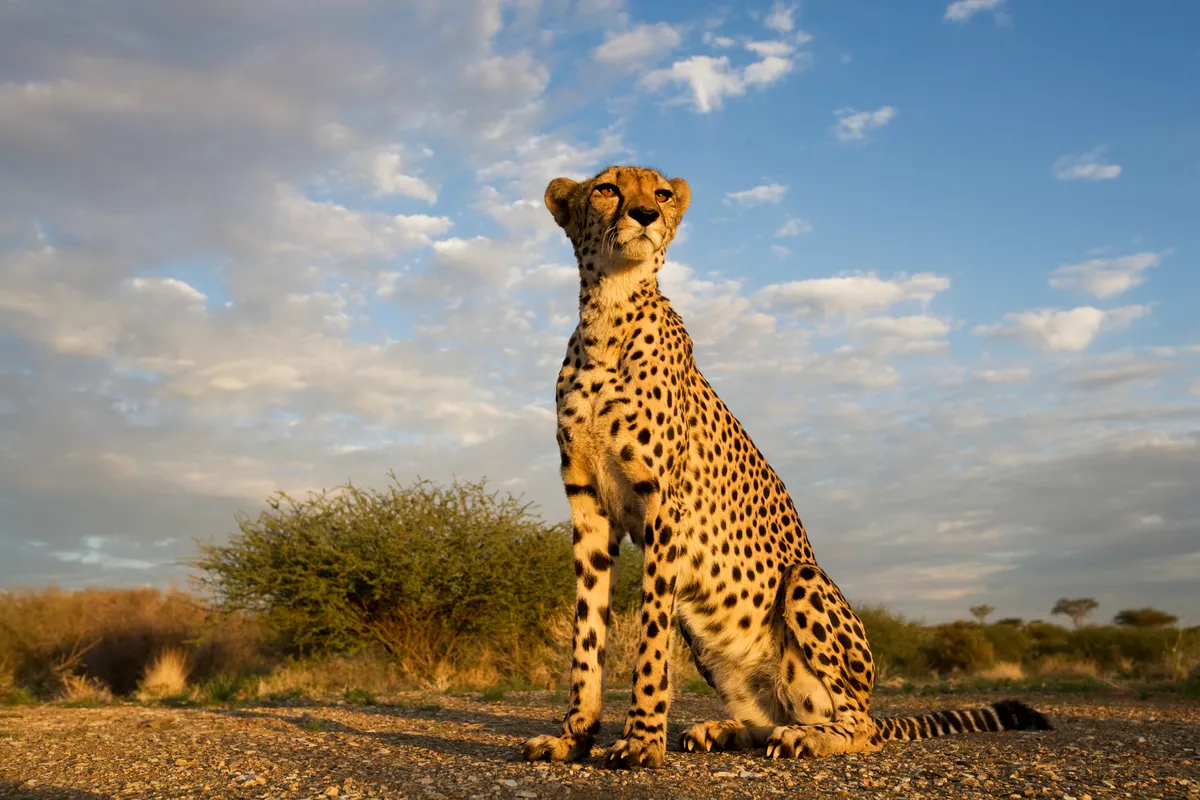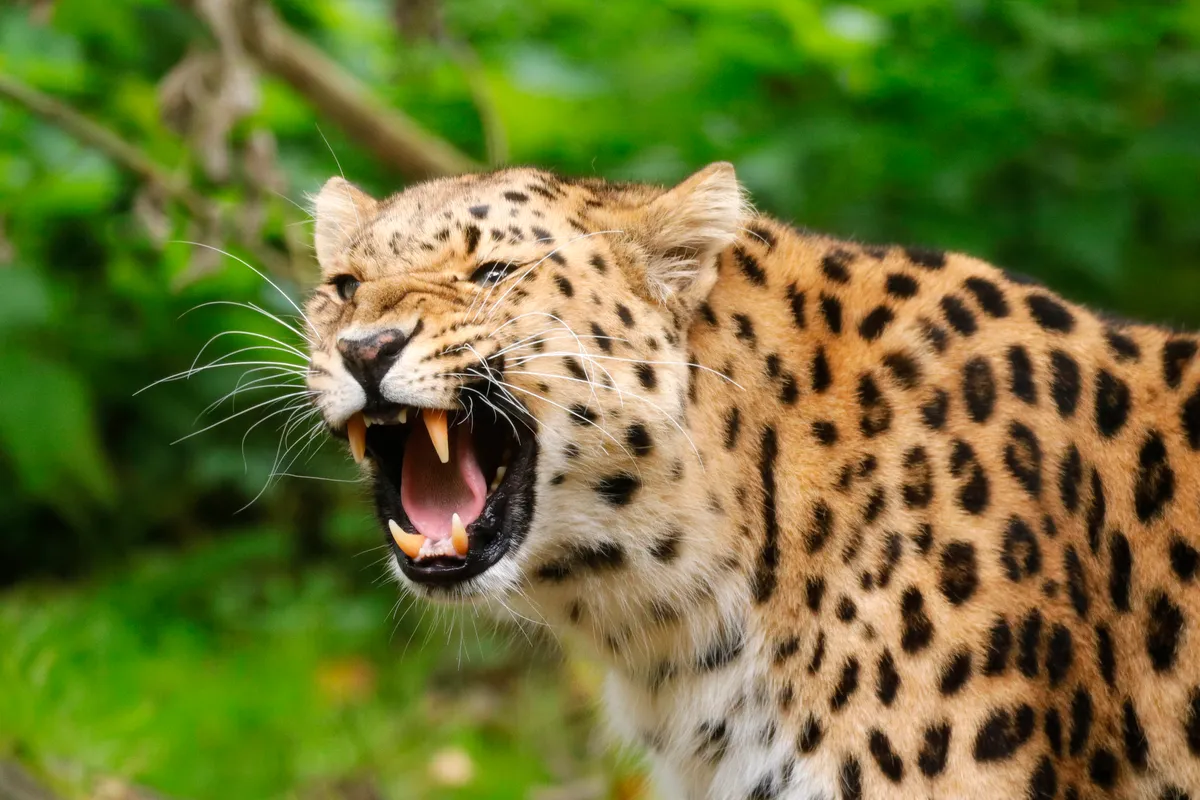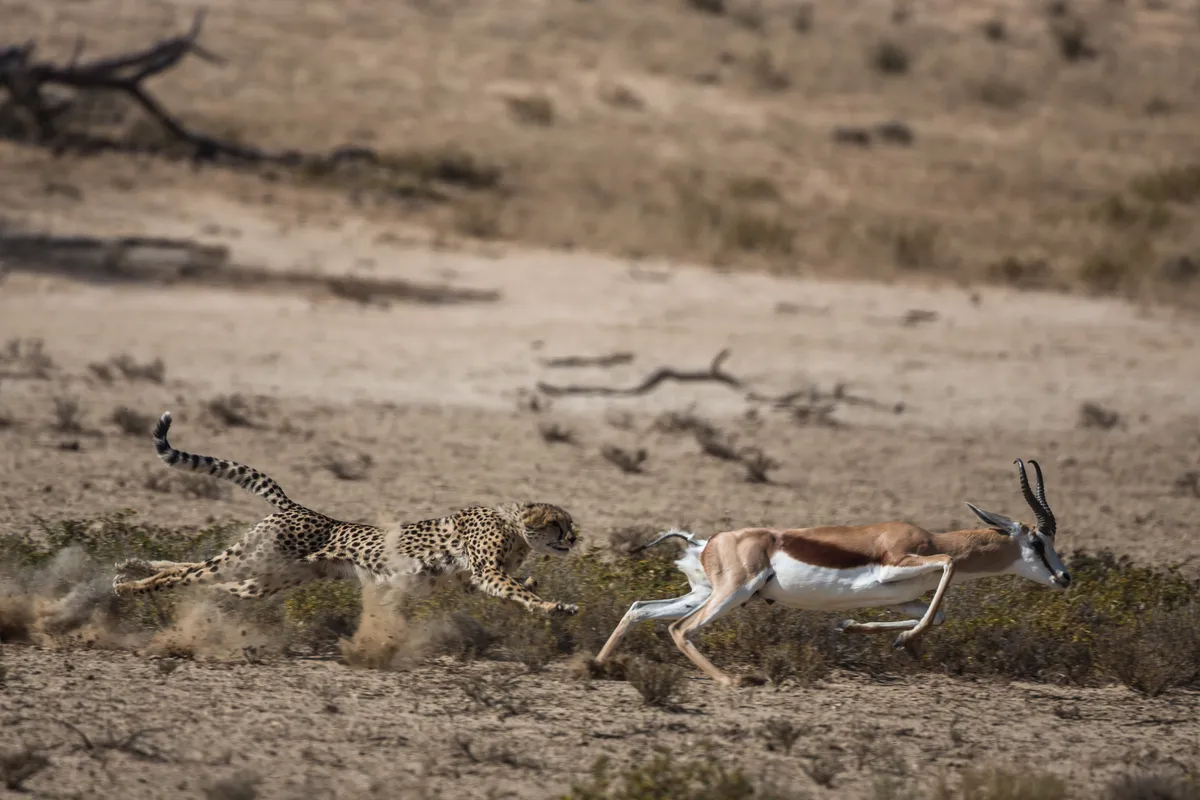At a glance, cheetahs (Acinonyx jubatus) and leopards (Panthera pardus) may look fairly similar, says the conservation charity Born Free. Both are felids, both have long tails, and both have coats and spots of a similar colour. They can both be found around Africa and hunt similar prey species.
However, take a closer look and you will notice that there are many differences in their appearance, and when it comes to behaviour and distribution they are not as alike as you may initially have thought.
How to tell the difference between a cheetah and a leopard?
Spots and coat colour aside, leopards are far bulkier, stronger and generally heavier than cheetahs, built for strength over speed or agility. Cheetahs, on the other hand, are the fastest land animal and have a need for speed, which means that they are light, agile, and stream-lined in their shape.
Cheetahs are taller at the head than leopards but shorter length-wise. However, leopards are widely regarded as the shortest of the big cats, as cheetahs are not considered by all to be true big cats due to the fact that they do not belong to the genus Panthera (which leopards do).
A cheetah's inability to roar can also be used to distinguish cheetahs from the big cats, although there are opposing sides regarding whether they should be regarded as such or not.
How does a cheetah's spots differ to a leopard's?

While they do both possess dark spots all over their coats, their spots are actually very distinct from one another. Cheetahs’ spots (above) are circular or oval in shape - solid blocks of colour of different sizes, some more like smudges or dapples than spots, and there are often small spots amongst the larger ones.

Leopards’ spots group together to make rosette shapes on their fur, usually showing the tan colour of their coats in the middle, at least on their bodies. On areas such as the legs, chest and face, the shapes are often black in the centre.
Leopards’ spots are often more pronounced on their faces than cheetahs’ are, but one of the biggest differences in facial features is the presence of black ‘tear lines’ on cheetahs’ faces, which run from the inner eyes down to the mouth. Speaking of the eyes, cheetahs’ are amber/brown, and leopards’ are green/blue.
Cheetah’s faces are also more rounded with smaller teeth, while leopards have a more elongated face with larger, more powerful jaws.
Of course, there is natural variation in appearance between both subspecies and individuals.
How does a cheetah run so fast?
While not a visible difference for the observer, cheetahs have larger nasal cavities than leopards, allowing them to breathe more efficiently when sprinting at great speed. Their lungs, heart and several other organs are large, relative to their size, for the same reason.
While running at speeds of up to 75 miles per hour, cheetahs’ wide, flat tails help them to balance. Their back feet are also larger than their front ones, allowing them to accelerate from rest to 64mph in three seconds! They can’t maintain their top speed for long though, and therefore must catch their prey as quickly as they can.
Achieving speeds of just less than half that of cheetahs, leopards have rounder tails and have larger front than back feet, which support their heavy front quarters and take down their prey. What they lack in speed they make up for in their ability to climb and the strength they possess to haul prey heavier than they are up trees, securing their catch for themselves.
Lastly, most cat species have retractable claws, which stay sharp by only being out when they are needed, but cheetahs’ claws are only semi-retractable and thus blunter, helping them to grip when they run by creating traction with the ground. Since leopards’ claws are fully retractable, the two species’ track marks can be distinguished by looking out for the presence of claw points in the tracks of the cheetah.
Which is stronger - leopard or cheetah?
Leopards’ strength enables them to outcompete cheetahs, chasing them away if they intrude on their territory, or even attacking them. There is cross-over between the two species, but they do not have identical ecological niches.
Do leopards and cheetahs hunt for prey the same way?
Leopards use brute force to kill their prey, jumping on them and taking them down. Their method of hunting can be called the ‘stalk and pounce’ method, or ‘ambush hunting’, and they can tackle larger prey than cheetahs can.
In fact, leopards may even pounce from the cover of a tree they have climbed. Like leopards, cheetahs also get close to their prey before giving chase, eventually tripping or otherwise knocking their prey off balance so that they can make the kill. Both then kill their prey with a bite to the neck (although cheetahs may take several minutes to kill their prey).
Once they have made the kill, they differ in how they then handle their meal. Cheetahs have to eat quickly and in secret if possible, often dragging their prey to a spot where it is not easily seen and eating as much as they can as quickly as possible.
This is because scavengers like hyenas soon come looking, based on the smell of the carcass in the air. Cheetahs do not have the strength to defend their kill against large scavengers, so they must abandon their feast. Leopards, on the other hand, cannot only defend themselves against scavengers, but can drag carcasses up trees to take them out of reach of most scavengers. As well as allowing them to eat their meal at their own pace, it even gives them the privilege of being able to go away then come back for more later.
Leopards usually hunt at night, and cheetahs usually during the day, although both can be seen hunting during day or night depending on the circumstances.
To help them hunt at night, leopards have a high number of light-sensitive cells in their eyes, better allowing them to detect shape and movement in the dark than cheetahs. They also have larger eyes and pupils, which allow them to take in more of the light that is present. Their night vision is believed to be seven times better than humans’!

Contrastingly, cheetahs are adapted to daytime hunting, with fewer rod photoreceptor cells (which function better in low light) in their retinas, and more cone photoreceptor cells (which are responsible for daylight vision) compared to other cat species. They are able to better avoid animals which hunt at night that way, as well as effectively see the terrain which they need to make high speed chases over.
As mentioned, cheetahs’ inability to roar is a factor which distinguishes them from the big cats. They and leopards can make a range of vocalisations, but cheetahs make yelps and chirps which sound surprisingly bird-like, and can easily be mistaken as such. Both species can spit, hiss and growl.
Leopards and female cheetahs are generally solitary, while male cheetahs often form coalitions of two to four related individuals. This helps them to take down larger prey.
What do cheetahs and leopards eat?
Both cheetahs and leopards are opportunistic predators with a wide range of potential prey, including small rodents, primates, ground dwelling birds and carrion, but their preferences differ.
Due to the slightness of cheetahs, they tend to prefer small to medium sized mammals, and mainly feed on ungulates such as impalas and springbok. Leopards can hunt prey of a greater size range, including large antelopes that may weigh twice as much as they do, allowing for a large kill to be eaten over several days from the safety of a tree. If food is in short supply, leopards have been known to eat almost anything going, including fish and beetles.
Where do cheetahs and leopards live? Do they share the same habitat?
Leopards and cheetahs can be found in similar habitats, but with their own unique preferences. Besides being most active at different times of day, they have different preferred habitat types for hunting.
Cheetahs’ excellent speed means that it is easier for them to give chase over open terrain with the space for this chase to be carried out. As leopards give less of a chase and rely on the element of surprise, they require cover from vegetation like trees and shrubs, and of course, benefit from trees which they can carry their carcasses up into. Leopards utilise trees more than cheetahs in other ways too, sleeping and lounging on them, while cheetahs, contrastingly, are not confident climbers.
Leopards have one of the widest geographical ranges of all the big cats (and compared to cheetahs), being found in deserts, rainforests, mountain regions, swamps and more. The species is made up of nine subspecies which have different adaptations to the habitats in which they live.
Apart from a small, critically endangered population in Iran, most cheetahs in the wild live in east, south-west and central Africa. They could once be found throughout Africa and in countries such as India, Russia, Pakistan and in the Middle East.
What threats do they face and are they endangered?
As mentioned, leopards have nine subspecies living in various habitats around the world. While leopards as a species are classed as Vulnerable by the International Union for Conservation of Nature (IUCN), with around 14,000 living in the wild, two of their subspecies are Endangered, and another two are Critically Endangered. The most endangered of all is the Amur leopard, which may be the most endangered big cat in the world, with only around 100 individuals remaining in the wild.
Cheetahs are also classed as Vulnerable, and have five subspecies, three of which are classed as Vulnerable, and two as Criticially Endangered. As mentioned above, the population in Iran – the Asiatic cheetah – is critically endangered, having suffered from hunting, habitat degradation and human-driven prey scarcity. Their natural migration has also been prevented due to border fencing between Iran and Turkmenistan, and only around 100 remain.
More generally, fewer than 7,000 adult cheetahs remain in the wild and their population is decreasing in number. This is compared to a population of around 100,000 in 1900, and with a shocking 50% decrease in the last forty years. Cheetahs suffer from low genetic diversity as a result of previous bottleneck events, leaving them vulnerable.
Leopards have lost up to three quarters of their habitat, and six of the nine leopard subspecies exist in less than 5% of their historic range and/or inhabit less than 100,000km².
Both species are impacted by many threats including the wildlife trade (both species being kept as exotic pets around the world), trophy hunting, loss of prey species, direct conflict with people and retaliatory killing, and habitat fragmentation and destruction. Cheetahs suffer specifically from bush encroachment, as they lack open grassland over which to give chase. This encroachment risks both cheetah injury, and cheetahs choosing to hunt livestock as an easier alternative to their natural prey, leading to conflicts.
For both species, times are tough and a lot of work is being done by wildlife organisations to try to turn around the decline of not just two vulnerable species, but critically endangered subspecies as well.
